Room 21 - Cappella dei Priori
This chapel was established in ca. 1450 to replace the original chapel (which now forms the first part of Room 4). It was located in the extension effected in 1429-43, and may well have been an after-thought. Its decoration (see below) began in 1454.
The city magistrates were moved from the top floor of the palace after 1534 to make way for the papal legates, and their chapel followed them to the floor below in 1553. The room was then put to secular use. It has recently been re-organised so that it has regained something of its original appearance.
Scenes from the Life of St Louis of Toulouse (1454-61)
In 1454, the chaplain Bartolomeo da Siena commissioned Benedetto Bonfigli to decorate “half of the chapel” of Palazzo dei Priori with frescoes depicting:
-
✴the Crucifixion with the Virgin and SS John the Evangelist, Laurence and Herculanus on the altar wall; and
-
✴four scenes from the life of St Louis of Toulouse.
One of three named artists - Fra Angelico, Domenico Veneziano or Filippo Lippi - was to evaluate the merits of the completed work and to establish the appropriate price.
The scope of the commission seems to have been changed at a later date, and the fresco of the Crucifixion was never executed. The other four scenes depict (clockwise from the right of the altar wall to the left of the back wall):
-
✴St Louis professing the Franciscan Rule before Pope Boniface VIII;
-
✴St Louis posthumously reuniting a merchant with his purse after a fish had swallowed it (which is set in a cityscape of Perugia is transported to a seaside location, with the Perugian church of San Domenico clearly identifiable above the three arches to the right);
-
✴St Louis performing another miracle (not identifiable because the fresco is badly damaged); and
-
✴St Louis's burial in a church that looks remarkably like the church of San Pietro, Perugia.
Work on these scenes was complete by 1461, when Filippo Lippi (the only one of the three named adjudicators who was still alive, who was working in Spoleto) was called to Perugia. He judged that the work was well done and set the price at 400 Florentine florins.
Scenes from the Life of St Herculanus (late 15th century)
Almost immediately, the Priors commissioned Benedetto Bonfigli to decorate the “other half of the chapel” with four frescoes depicting scenes from the life of St Herculanus. Each of these was to be completed in six months so that the work would be completed in two years. Again the commission changed: Bonfigli painted only three scenes, but one of them (see below) occupied the whole of the left wall.
Totila's siege of Perugia
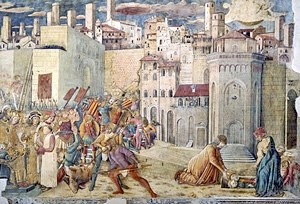
This scene, which is on the right of the back wall, is in two parts:
-
✴On the left, Totila's soldiers are camped in the ruins of the amphitheatre outside Porta Marzia, effecting the siege of Perugia that had begun in 542. It is now 549, and they gather around a fattened ox that St Herculanus has thrown from the walls in order to convince them that the city still has provisions. However, a young cleric testifies on oath before Totila that this is a ruse, and that the city is close to surrender
-
✴On the right, the scene is set after the city has fallen and St Herculanus has been beheaded. A few brave souls recover his body (with the head miraculously in place), together with that of a young boy with whom he had been buried.
This scene is set in a cityscape that gives a valuable picture of Colle Landone before the building of the Rocca Paolina (1540). Thus we see the ruins of the Roman amphitheatre, Porta Marzia before its relocation, the towers of the Baglioni palaces and the church of Sant' Ercolano before the demolition of its upper storey.
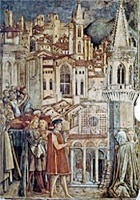
The cityscape shows:
-
✴the portico, campanile and facade of San Pietro before the construction of the outer cloister (on the right in this detail);
-
✴the apse of San Domenico and its campanile, the upper part of which was later demolished (on the left in this detail);
-
✴the campanile of San Domenico Vecchio behind it, which no longer exists; and
-
✴(for a second time) the church of Sant' Ercolano before the demolition of its upper storey.
Translation to the Duomo
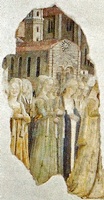
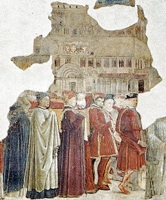
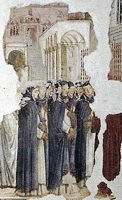
San Domenico Vecchio Palazzo dei Priori Duomo
This scene, which covers the whole of the left wall, depicts the subsequent translation of the relics of St Herculanus from San Pietro to the Duomo in ca. 936. This is logically the last scene in the story, but Bonfigli inserted it between the other two in the clockwise sequence, presumably because the unbroken expanse of the left wall served his compositional needs.
Unfortunately, this fresco is very badly damaged and much of it is completely lost. The surviving fragments of the procession show:
-
✴a group of women passing San Domenico Vecchio (now largely demolished along with its campanile);
-
✴the city magistrates passing along the side of the Palazzo dei Priori; and
-
✴a group of Dominicans about to enter the side door of the Duomo (before its reconstruction in the 15th century), with the Loggia di Braccio extending as far as the (later destroyed) Palazzo del Podestà.
Dating
Although the original contract (1461) stipulated that these frescoes were to be completed in two years, the actual execution took far longer. Bonfigli seems to have downed tools in 1462, probably having completed only the first of the three scenes (the siege of Totila). The main reason seems to have been that the Commune had been slow to pay the 400 Florentine florins that were due in respect of the earlier commission. In 1469, the contract was renegotiated and the Commune assigned to Bonfigli a debt owed by one Bartolomeo di Gregorio.
Some of this money was still outstanding when Bonfigli died in 1496, and he generously stipulated in his will that the balance should be used to complete the decoration of the chapel. This does not necessarily imply that Bonfigli’s frescoes were incomplete at that point: the legacy could have related to the commission of the Decemviri Altarpiece (see below) or to other aspects of the decoration of the chapel.
Two clues can be gleaned from the frescoes themselves:
-
✴the arms of Pope Sixtus IV (1471-84) appear above the entrance to the Palazzo dei Priori on the left wall; and
-
✴the scene of the translation to San Pietro (altar wall) omits two monuments that Bonfigli probably would have included had they been complete:
-
•the octagonal church of the Madonna di Braccio (1478); and
-
•the outer part of Porta San Pietro (completed in 1481).
Another piece of circumstantial evidence is provided by the fact that the Priors commissioned the altarpiece for the chapel in 1479 (see below), suggesting that the frescoes were at least approaching completion. Thus, on balance, it is likely that the last two scenes were largely painted in the 1470s.
Crucifixion with SS Francis and Herculanus (ca. 1565)
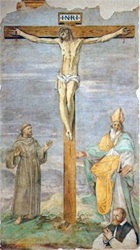
The fresco depicts the Crucifixion set in a landscape, with standing figures of SS Francis and Herculanus to the sides. The praying figure shown half-length on the bottom right is probably Francesco Bossi.
Art from the Chapel
Decemviri Altarpiece (1495-6)
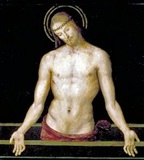
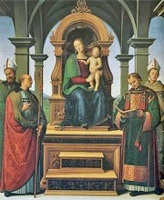
Upper panel Main panel
In situ Pinacoteca Vaticana, Rome
Replaced in the chapel by a copy
The Decemviri (ten magistrates) originally commissioned an altarpiece for this chapel in 1479 from Pietro di Galeotto. The main panel was to depict the Madonna and Child with SS Laurence, Louis of Toulouse, Herculanus and Constantius, while the smaller upper panel could be of a subject of his choice. Although the contract stipulated that a steep penalty would arise unless the work was delivered within two years, it remained incomplete at the time of Pietro’s death in 1483.
In 1484, the commission passed to Perugino, who was to complete the main panel within four months and to paint the upper panel within a year. The subject of the latter was to be the Madonna della Misericordia with portraits of the Decemviri, who would presumably be depicted sheltering under her cloak. When Perugino left the city a month later without having started the work, the commission passed to Sante di Apollonio, who executed the upper panel, which depicted the Madonna della Misericordia. He seems to have lost the commission in 1485, and he died in the following year.
In 1485, the priors renewed Perugino’s contract. However, they paid him only a nominal sum, and nothing further seems to have happened until 1495, when the contract was again renewed. This time, Perugino received a substantial sum, in return for which he was required to repaint the existing upper panel, replacing the Madonna della Misericordia with a Pietà, and to complete the main panel within six months. This he seems to have achieved.
The delivered altarpiece had two panels within a gilded wooden frame:
-
✴The main panel depicted the Madonna and Child on an elevated throne under an arcade, flanked by SS Herculanus, Constantius, Laurence and Louis of Toulouse. Perugino’s signature appears at the base of the throne.
-
✴The smaller upper panel depicted Christ in the coffin, in which the half-length figure of Christ displays His wounded hands, painted over the earlier Madonna della Misericordia by Sante di Apollonio.
The altarpiece was moved to the new chapel on the first floor of the palace in 1553. Napoleon's commissioner, Jacques-Pierre Tinet selected the main panel for confiscation in 1797, and a copy (ca. 1799) by Domenico Garbi was put in its place. Antonio Canova recovered it in 1815 but, despite the requests of the city authorities for its return, it remains in the Pinacoteca Vaticana, Rome.
In 1835, the altarpiece (with the copy of its main panel) was removed from the first floor chapel but the components remained in Perugia. Perugino's original upper panel and the copy of the main panel were subsequently displayed separately in the gallery. They have recently been reassembled in the original frame and in the original location.
Galleria Nazionale: Sala Podiani and Sala Conferenze Rooms 1-3 Room 4
Rooms 5-6 Rooms 7-10 Rooms 11-16 Room 17 Rooms 18-20 Cappella dei Priori
Rooms 22-28 Rooms 29-32 Rooms 33-40 Deposit
Return to Museums of Perugia.
Return to Walk I.



